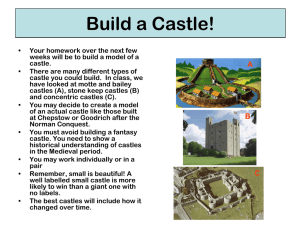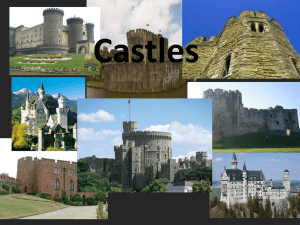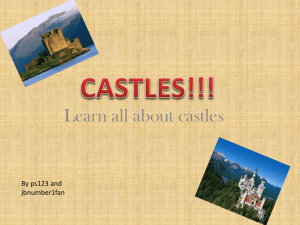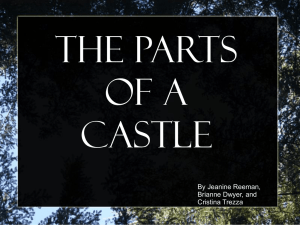Motte and Bailey Castles!
advertisement
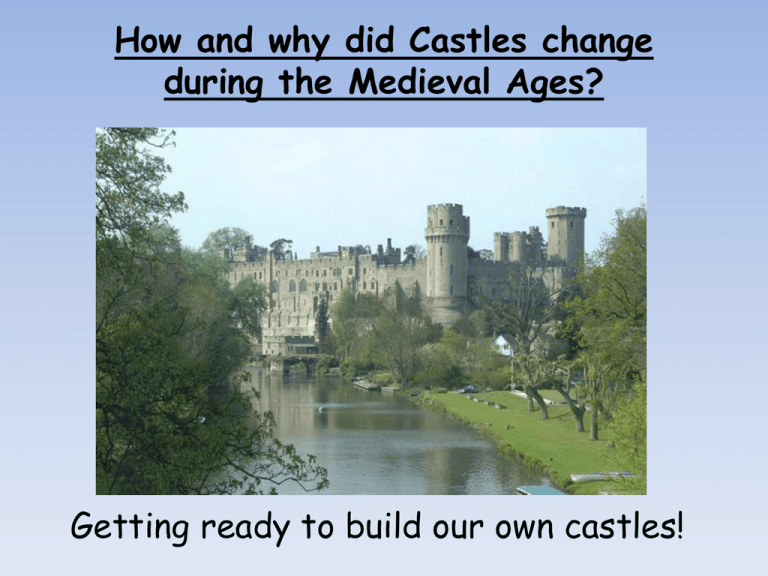
How and why did Castles change during the Medieval Ages? Getting ready to build our own castles! Learning outcomes for the Extended Homework Project This half term you will look into the major changes in medieval castles and the reasons behind these. Through a number of different tasks you will discover just how important castles were to medieval people, what made them strong and what impact they had on people’s lives at the time. Finally you will use your understanding to design and make a model of your very own castle showing just what you have learnt about what makes a castle successful and strong. Perseverance Making good use of resources Planning learning in advance What’s the link between these? Answer All these things have something to do with PROTECTION! Medieval Castles Between 1066 – 1500 over 1,500 castles were built in England and Wales. Over this time the way they were built changed a great deal. Most of the reasons castles changed were because attackers found new ways of breaking into them. Castle defences needed to change to keep these attackers out. Background - Norman conquest! • King William I defeated the Saxons at the Battle of Hastings and spent the next 20 years • During this time he built over 100 Motte and Bailey Castles. • These were important bases to protect Norman troops and keep an eye on local unrest. William’s immediate problems • Geography • Language • A hostile population Motte and Bailey Castles! When William came over from Normandy he quickly began building Motte and Bailey castles. Although quick and simple to build, the Motte and Bailey castle also had weaknesses. Because this type of castle was built from wood it could easily be set on fire and would rot over time. Sooner or later an enemy would realize the weaknesses of these castles, so a more permanent solution was needed. The end of the Motte and Bailey The Normans quickly set about building castles made of stone. These type of castles were called Square Keep castles. Why do you think this spelt the end of Motte and Bailey castles? The Motte was too weak to hold the huge weight of the stone castles. Inside a stone keep castle What was life like inside a Stone Keep castle? Life in a stone keep castle was better than in a Motte and Bailey… but not by much! There was more room inside, but it was still draughty and much of the castle was built around the idea of defence, not luxury. The walls were 4 metres thick in places. Stone Keep castles were also extremely heavy. This meant that they couldn't be built on the old Motte and Bailey castle sites, because the man-made Motte would not support the weight of all the stone! Life in the castle “We get up around 6 a.m. It is cold and damp by then and my limbs are stiff from sleeping on the floor, I have to remember to remove any strands of hay which get stuck in my clothes as I sleep on them. While the men make the fires, I go down to the stores to get food for the Lord and Lady’s breakfast. I open the shutters in the Lord’s bedroom and help Lady Jane get dressed. I send for one of the castle boys as the guardrobe is smelling terribly and the pit needs clearing.” Mary Smith, 1115. Is this account reliable? Why? Does it add anything useful to your knowledge of castle life? A Medieval Castle Bailey – A safe place to shelter during an attack Merlons – raised stonework Keep ~ Walls 2.5 m thick Wall Towers ~ with splay bottoms Crenels Curtain Wall Round Towers Moat Gatehouse with a drawbridge at the front. Arrow Slits Hoarding with leather cover ~ used to protect the towers and walls when being attacked Further castle developments Stone keep castles were good, but they still had weaknesses. Because they were built with corners, they could be easily weakened if an enemy tunnelled underneath and collapsed the tunnel. This would cause the keep’s edges to fall through the ground into the tunnel, and cause the keep to either lean over or collapse! What solutions do you think there might be to this design problem? The solution actually came from the Crusades! The Crusaders, Christian knights who had fought in distant countries, brought back a new type of castle design with them. These were Concentric castles with circular towers. This meant the castle had a layered defence of many towers. There were few corners and so enemies mining beneath was less of a problem. Later on, comfort became more important as life in England became less violent. Some castles were just fortified stately homes. How did castles develop? Main Task • Your task is to design and build a miniature medieval castle. Use the information in this PowerPoint to help you decide the best way to approach this. • It is your choice which style of castle you decide to make (Motte and Bailey, Stone Keep, etc…). • You must submit your castle by no later than Friday 12th December to your History teacher. Castles bigger than an A4 sheet of paper will not be accepted! • Good luck and happy building! G&T Focus: The model could be of an existing castle and will include supporting evidence such as labels and historical information to go with your castle, this could be in the form of a fact sheet, a written account or even a visitor guide book Level 3: Show knowledge and understanding of some of the main changes studied. • Begin to give a few reasons for, and results of, the main events and changes. Level 4: describe some of the main events, people and periods studied. • Identify some causes and consequences of the main events and changes Level 5: describe features of past societies and periods in the context of developing chronological framework. Begin to recognise and describe the nature and extent of change and continuity. Begin to recognise why some events, people and changes might be judged as more historically significant than others. What makes a strong castle? What could you put into your design?
